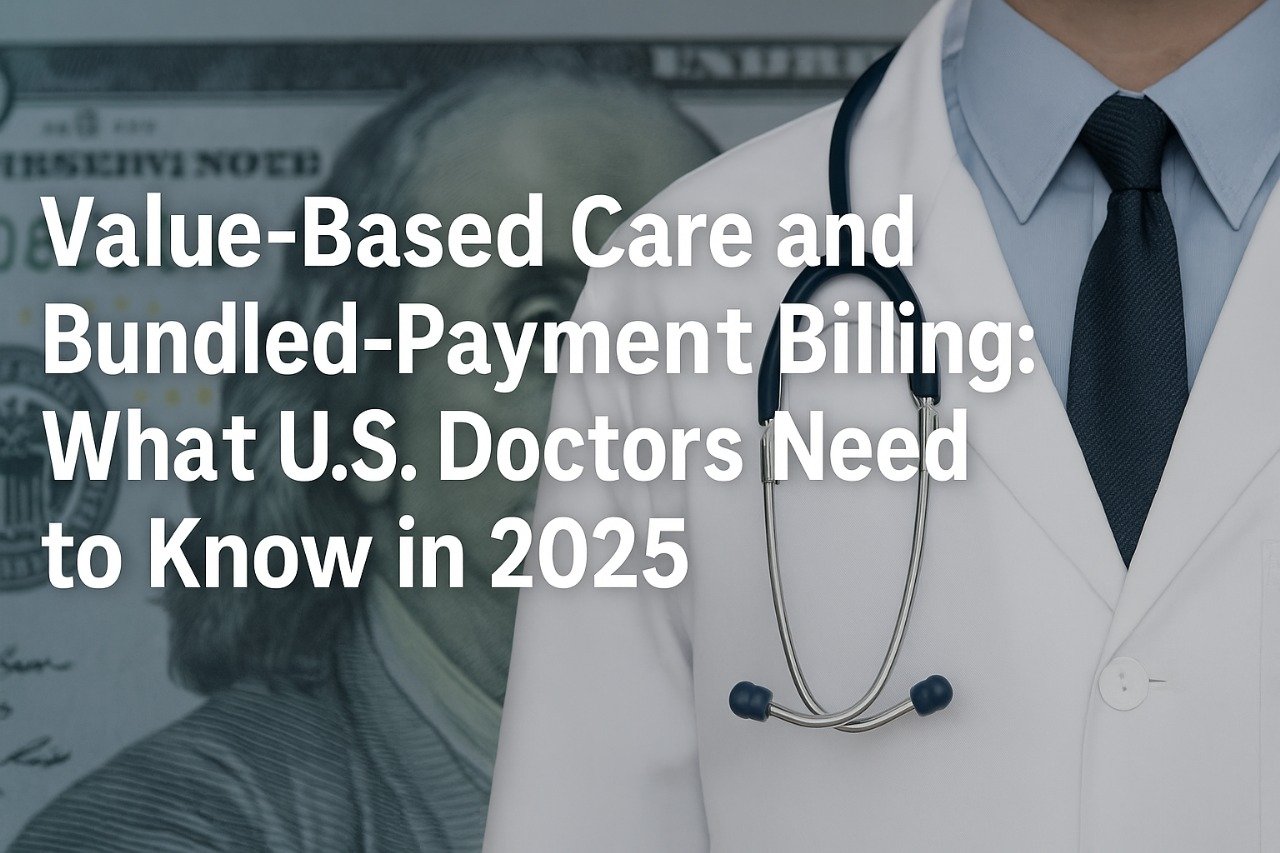
Introduction
In recent years, U.S. healthcare has been steadily moving away from traditional fee‑for‑service billing and toward value‑based care (VBC) and bundled‑payment models. These frameworks link physician compensation to patient outcomes, quality of care and overall cost control. As CMS and commercial payers ramp up these models in 2025, understanding their structure, billing nuances and operational demands is crucial for practices of all sizes. This blog explores fundamentals of value‑based care, highlights key bundled‑payment programmes and offers practical advice for successful participation.
What Is Value‑Based Care?
Value‑based care fundamentally reimagines how physicians are paid. Instead of being reimbursed for each service, providers earn based on quality metrics and efficiency. Accountable Care Organizations (ACOs), which tie reimbursement to patient satisfaction, disease management and cost containment, are flagship example. According to CMS, ACOs encourage collaboration among hospitals, specialists and primary care teams to enhance care and reduce unnecessary hospital stays (ravenhealth.com). By enforcing accountability for quality and total cost, ACOs help align clinical goals with financial incentives.
Bundled Payments Explained
Bundled payments, also known as episode-based payments, provide single lump sum for all services tied to specific medical event—such as knee replacement or heart attack—over designated time span (mdclarity.com). These models can be structured retrospectively (where providers reconcile against target) or prospectively (where central payer distributes funds up front). Both approaches incentivize better coordination, cost efficiency and standardised care pathways. Evidence from BPCI‑Advanced programme suggests cost savings of 2–5% per episode with no compromise to patient outcomes (mdclarity.com).
Key Programs in 2025
BPCI‑Advanced
The CMS Bundled Payments for Care Improvement (BPCI‑Advanced) programme, originally set to expire in 2025, has been extended into 2025, helping hospitals and physician groups collaborate on bundled episodes (mdclarity.com). Data show physician-led teams often save more under these models, particularly for surgical cases like joint replacements (facs.org). Importantly, BPCI‑Advanced covers both acute hospital services and post-acute care like rehab—spanning 30–90 days.
TEAM Model (Mandatory Starting 2026)
CMS is launching mandatory bundled‑payment model called TEAM (Transforming Episode-Based Accountability). This focuses on high-cost surgical and acute procedures such as joint replacements and cardiac bypass, becoming effective January 1, 2026, across 741 hospitals in 188 regions (facs.org). Under TEAM, hospitals and their surgical teams share financial risk and rewards across full episodes—from admission through recovery.
Advanced Primary Care Bundles
CMS is also introducing bundled payments for primary care teams as part of hybrid value‑based strategy (aafp.org). These new codes enable monthly reimbursement for managing complex patients, aligning primary care with chronic disease management and prevention goals—a shift emphasised in CMS’s 2025 physician fee schedule (kff.org).
Financial and Operational Implications
Bundled‑payment participation brings both opportunity and challenge. Providers can benefit financially through shared savings, but they also take on cost overruns and outcome risks. To succeed, provider groups need strong data analytics, care coordination teams (e.g., navigators) and integrated EHR workflows (ravenhealth.com). Operationally, practices must:
- Map all services in care episode and track all costs.
- Align workflows across pre‑op, inpatient care, discharge and post‑acute settings.
- Ensure timely communication with specialists, therapists and truancy services.
- Monitor quality and cost metrics diligently to qualify for incentives and avoid penalties.
Specialist Engagement
Although value‑based models historically emphasised primary care, engaging specialists has become essential. Specialist involvement is critical for successful surgical episodes—surgeons lead about 75% of joint-replacement bundles (ama-assn.org, cokergroup.com, en.wikipedia.org). Partnering specialists with primary care enables true accountability for outcomes and cost.
Policy Considerations
Despite enthusiasm for bundling and VBC, policy shifts can unsettle momentum. recent “doc fix” budget proposal consolidates Medicare payment updates into single inflation‑tied factor starting in 2026. While this offers payment stability, it may also dilute incentives for providers to participate in alternate payment models (axios.com, axios.com). Moreover, ongoing 2.83% rate cuts under 2025 Physician Fee Schedule tighten baseline revenues—even for value‑based participants (cms.gov).
Strategies for Physician Practices
- Evaluate readiness – Determine whether you have infrastructure, data systems and personnel to manage bundled episodes.
- Pilot selected bundles – Start with common procedures like joint replacements or chronic condition management.
- Build care coordination teams – Employ navigators or case managers to support patients across settings.
- Track metrics proactively – Monitor versus target costs, readmissions and patient-reported outcomes.
- Engage stakeholders – Include specialists, hospitals and post-acute providers early and collaboratively.
- Advocate for fair policy – Help shape payment reform by providing feedback to CMS and legislators.
Conclusion
Value‑based care and bundled payments are reshaping incentives in 2025, offering real potential for improved outcomes and cost efficiency. However, onboarding into these frameworks requires careful planning, robust coordination and readiness for shared risk. For physician groups willing to invest in analytics, coordination and collaborative care models, bundled payments can deliver financial reward and quality improvement. Still, policy and payment stability will determine how widely—and successfully—these models expand. Now is ideal time for practices to assess readiness, engage stakeholders and position themselves for this next era in reimbursement.



